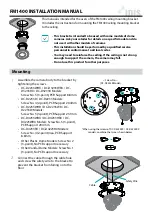
Configuring the Terminal
3-17
3
Saving Configuration Changes in Flash Memory
The terminals use two copies of the configuration:
Runtime or RAM configuration
is the current or active set of parameters and options
enabled on the terminal. The configuration is stored in RAM and will be lost if you boot
or reset the terminal.
Boot or flash configuration
is the set of parameters and options last saved in flash
memory. The configuration is stored in flash memory and will be saved and used if you
boot or reset the terminal.
Here are the four ways you can configure the terminal and how the configuration is
updated:
Configure the Terminal
Runtime or RAM
Configuration Updated?
Boot or Flash
Configuration Updated?
Using the TRAKKER Antares
2400 Menu System
Yes (see Note)
Yes (see Note)
Scanning bar code labels
Yes
No
From a host application through
the serial port
Yes
No
T2425 from the network
(DCS 300 or host)
Yes
No
Note: You are prompted to save your changes in RAM and flash as you exit the
Configuration Menu and the TRAKKER Antares 2400 Menu System. Your changes are
saved if you choose Yes at each screen.
If you configure the terminal by scanning bar code labels, through the serial port, or from
the network, you may want to save the changes in flash memory using one of these
methods:
•
Scan or send the Save Configuration in Flash Memory reader command.
•
Use the TRAKKER Antares 2400 Menu System.
To save configuration changes using the reader command
•
Scan this bar code label:
Save Configuration in Flash Memory
*.+1*
*.+1*
Or, send the command
.+1
as the last command from the controller or host
application. For help, see Chapter 4, “Operating the Terminal in a Network.”
Summary of Contents for Trakker Antares 2420
Page 1: ...TRAKKERAntares 2420and2425 Hand HeldTerminal P N 064024 006 User s Manual...
Page 15: ...nuggetf code39 Contents xv Glossary Index G I...
Page 16: ...xvi...
Page 24: ...xxiv...
Page 25: ...nuggetf code39 Getting Started 1...
Page 26: ...1 2...
Page 60: ...1 36...
Page 61: ...Learning How to Use the Terminal 2...
Page 62: ...2 2...
Page 103: ...Co de 39 Nugget Configuring the Terminal 3...
Page 104: ...Co de 39 Nugget 3 2...
Page 134: ...3 32...
Page 135: ...Operating the Terminal in a Network 4...
Page 136: ...4 2...
Page 173: ...Using Custom Applications 5...
Page 174: ...5 2...
Page 193: ...Troubleshooting 6...
Page 194: ...6 2...
Page 219: ...Running Diagnostics 7...
Page 220: ...7 2...
Page 243: ...Reader Command Reference 8...
Page 244: ...8 2...
Page 268: ...8 26...
Page 269: ...Configuration Command Reference 9...
Page 270: ...9 2...
Page 389: ...Terminal Specifications A...
Page 390: ...A 2...
Page 404: ...A 16...
Page 405: ...Full ASCII Charts B...
Page 406: ...B 2...
Page 415: ...International Character Support C...
Page 416: ...C 2...
Page 427: ...Using the Default Applications D...
Page 428: ...D 2...
Page 438: ...D 12...
Page 439: ...Glossary G...
Page 440: ...G 2...
Page 463: ...Index I...
Page 464: ...I 2...
Page 480: ...I 18...
















































